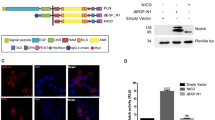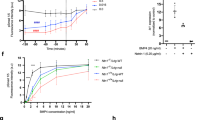Abstract
Ligands that are capable of activating Notch family receptors are broadly expressed in animal development, but their activity is tightly regulated to allow formation of tissue boundaries1. Members of the fringe gene family have been implicated in limiting Notch activation during boundary formation2,3,4,5,6,7,8, but the mechanism of Fringe function has not been determined. Here we present evidence that Fringe acts in the Golgi as a glycosyltransferase enzyme that modifies the epidermal growth factor (EGF) modules of Notch and alters the ability of Notch to bind its ligand Delta. Fringe catalyses the addition of N-acetylglucosamine to fucose, which is consistent with a role in the elongation of O-linked fucose O-glycosylation that is associated with EGF repeats. We suggest that cell-type-specific modification of glycosylation may provide a general mechanism to regulate ligand–receptor interactions in vivo.
This is a preview of subscription content, access via your institution
Access options
Subscribe to this journal
Receive 51 print issues and online access
$199.00 per year
only $3.90 per issue
Buy this article
- Purchase on Springer Link
- Instant access to full article PDF
Prices may be subject to local taxes which are calculated during checkout





Similar content being viewed by others
References
Irvine, K. D. Fringe, Notch, and making developmental boundaries. Curr. Opin. Genet. Dev. 9, 434–441 ( 1999).
Panin, V. M., Papayannopoulos, V., Wilson, R. & Irvine, K. D. Fringe modulates Notch–ligand interactions. Nature 387, 908–913 (1997).
Johnston, S. H. et al. A family of mammalian Fringe genes implicated in boundary determination and the Notch pathway. Development 124 , 2245–2254 (1997).
Fleming, R. J., Gu, Y. & Hukriede, N. A. Serrate-mediated activation of Notch is specifically blocked by the product of the gene fringe in the dorsal compartment of the Drosophila wing imaginal disc. Development 124, 2973–2981 (1997).
Rodriguez-Esteban, C. et al. Radical fringe positions the apical ectodermal ridge at the dorsoventral boundary of the vertebrate limb. Nature 386, 360–366 (1997).
Laufer, E. et al. Expression of Radical fringe in limb-bud ectoderm regulates apical ectodermal ridge formation. Nature 386, 366–373 (1997).
Zhang, N. & Gridley, T. Defects in somite formation in lunatic fringe-deficient mice. Nature 394, 374– 377 (1998).
Evrard, Y. A., Lun, Y., Aulehla, A., Gan, L. & Johnson, R. L. lunatic fringe is an essential mediator of somite segmentation and patterning. Nature 394, 377– 381 (1998).
Rulifson, E. J. & Blair, S. S. Notch regulates wingless expression and is not required for reception of the paracrine wingless signal during wing margin neurogenesis in Drosophila. Development 121, 2813– 2824 (1995).
Diaz-Benjumea, F. J. & Cohen, S. M. Serrate signals through Notch to establish a Wingless-dependent organizer at the dorsal/ventral compartment boundary of the Drosophila wing. Development 121, 4215–4225 ( 1995).
Kim, J., Irvine, K. D. & Carroll, S. B. Cell recognition, signal induction and symmetrical gene activation at the dorsal/ventral boundary of the developing Drosophila wing. Cell 82, 795– 802 (1995).
Doherty, D., Fenger, G., Younger-Shepherd, S., Jan, L. -Y. & Jan, Y.-N. Dorsal and ventral cells respond differently to the Notch ligands Delta and Serrate during Drosophila wing development. Genes Dev. 10, 421–434 (1996).
de Celis, J. F., Garcia-Bellido, A. & Bray, S. J. Activation and function of Notch at the dorsal-ventral boundary of the wing imaginal disc. Development 122 , 359–369 (1996).
Irvine, K. & Wieschaus, E. fringe, a boundary specific signalling molecule, mediates interactions between dorsal and ventral cells during Drosophila wing development. Cell 79, 595–606 (1994).
Wu, J. Y., Wen, L., Zhang, W. J. & Rao, Y. The secreted product of Xenopus gene lunatic Fringe, a vertebrate signaling molecule. Science 273, 355–358 ( 1996).
Yuan, Y. P., Schultz, J., Mlodzik, M. & Bork, P. Secreted fringe-like signaling molecules may be glycosyltransferases. Cell 88, 9–11 (1997).
Amado, M., Almeida, R., Schwientek, T. & Clausen, H. Identification and characterization of large galactosyltransferase gene families: galactosyltransferases for all functions. Biochim. Biophys. Acta 1473, 35–53 ( 1999).
Röttger, S. et al. Localization of three human polypeptide GalNAc-transferases in HeLa cells suggests initiation of O-linked glycosylation throughout the Golgi apparatus. J. Cell Sci. 111, 45– 60 (1998).
Nilsson, T. & Warren, G. Retention and retrieval in the endoplasmic reticulum and the Golgi apparatus. Curr. Opin. Cell Biol. 6, 517–521 (1994).
Breton, C. & Imberty, A. Structure/function studies of glycosyltransferases. Curr. Opin. Struct. Biol. 9, 563– 571 (1999).
Gastinel, L. N., Cambillau, C. & Bourne, Y. Crystal structures of the bovine β4galactosyltransferase catalytic domain and its complex with uridine diphosphogalactose. EMBO J. 18, 3546–3557 ( 1999).
Harris, R. J. & Spellman, M. W. O-linked fucose and other post-translational modifications unique to EGF modules. Glycobiology 3 , 219–224 (1993).
Moloney, D. J. & Haltiwanger, R. S. The O-l fucose glycosylation pathway: identification and characterization of a uridine diphosphoglucose: fucose-β1,3-glucosyltransferase activity from Chinese hamster ovary cells. Glycobiology 9, 679–687 (1999).
Blaumueller, C. M., Qi, H., Zagouras, P. & Artavanis-Tsakonas, S. Intracellular cleavage of Notch leads to a heterodimeric receptor on the plasma membrane. Cell 90, 281–291 (1997).
Logeat, F. et al. The Notch1 receptor is cleaved constitutively by a furin-like convertase. Proc. Natl Acad. Sci. USA 95, 8108–8112 (1998).
Goode, S. & Perrimon, N. Brainiac and fringe are similar pioneer proteins that impart specificity to notch signaling during Drosophila development. Cold Spring Harb. Symp. Quant. Biol. 62, 177–184 (1997).
Bergemann, A. D., Cheng, H. J., Brambilla, R., Klein, R. & Flanagan, J. G. ELF-2, a new member of the Eph ligand family, is segmentally expressed in mouse embryos in the region of the hindbrain and newly forming somites. Mol. Cell. Biol. 15, 4921–4929 (1995).
Amado, M. et al. A family of human β3-galactosyltransferases. Characterization of four members of a UDP-galactose:β-N-acetyl-glucosamine/β- N acetyl-galactosamine β-1,3-galactosyltransferase family. J. Biol. Chem. 273, 12770–12778 (1998).
Brückner, K. et al. EphrinB ligands recruit GRIP family PDZ adaptor proteins into raft membrane microdomains. Neuron 22, 511 –524 (1999).
Stanley, H., Botas, J. & Malhotra, V. The mechanism of Golgi segregation during mitosis is cell type-specific. Proc. Natl Acad. Sci. USA 94, 14467–14470 (1997).
Acknowledgements
We thank T. Nilsson for information about Golgi retention sequences; V. Malhotra for antibody to Drosophila Golgi; M. Fortini for Notch and Delta expression plasmids; A.-M. Voie for transgenic strains and F. Peverali for his contributions at an early stage of the work. K.B. thanks K. Prydz and D. Toomre for technical discussion; B. Keck and T. Schwientek for introduction to glycosyltransferase assays. H.C. is supported by the Danish Cancer Center and the Velux Foundation.
Author information
Authors and Affiliations
Corresponding author
Rights and permissions
About this article
Cite this article
Brückner, K., Perez, L., Clausen, H. et al. Glycosyltransferase activity of Fringe modulates Notch–Delta interactions . Nature 406, 411–415 (2000). https://doi.org/10.1038/35019075
Received:
Accepted:
Issue Date:
DOI: https://doi.org/10.1038/35019075
This article is cited by
-
A single-cell atlas of Drosophila trachea reveals glycosylation-mediated Notch signaling in cell fate specification
Nature Communications (2024)
-
Impact of heterozygous ALK1 mutations on the transcriptomic response to BMP9 and BMP10 in endothelial cells from hereditary hemorrhagic telangiectasia and pulmonary arterial hypertension donors
Angiogenesis (2024)
-
Wnt, notch signaling and exercise: what are their functions?
Human Cell (2024)
-
Identification of acquired Notch3 dependency in metastatic Head and Neck Cancer
Communications Biology (2023)
-
1H, 15N, 13C backbone and sidechain resonance assignments and secondary structure of mouse NOTCH1 EGF27
Biomolecular NMR Assignments (2022)
Comments
By submitting a comment you agree to abide by our Terms and Community Guidelines. If you find something abusive or that does not comply with our terms or guidelines please flag it as inappropriate.



